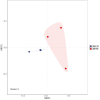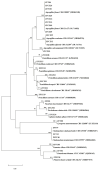Diversity, antibacterial and antioxidant activities of fungi associated with Apis cerana
- PMID: 40761805
- PMCID: PMC12320804
- DOI: 10.7717/peerj.19762
Diversity, antibacterial and antioxidant activities of fungi associated with Apis cerana
Abstract
Insect-associated fungi are a treasure trove of natural active compounds. Nevertheless, the diversity and biological activities of fungi associated with Apis cerana have not been studied in depth. Here, we investigated fungal diversity in the A. cerana gut and honeycomb using a combination of culture-dependent and -independent methods. A total of 652 fungal operational taxonomic units belonging to five phyla and 334 genera were detected in the samples. Significant differences were found in the fungal communities of the honeybee gut and honeycomb-the genera Fusarium, Stenocarpella, and Botrytis were dominant in the gut, whereas Botrytis, Periconia, and Aspergillus were dominant in honeycomb. A total of 28 fungal strains were isolated from honeybee gut, head, and honeycomb, belonging to two phyla, four classes, and 10 genera. Most of these isolates were identified as Aspergillus, Penicillium, and Cladosporium spp. The antibacterial and antioxidant activities of crude extracts of their fermentation broths were investigated. Extract from A. subramanianii ZFCZ33 exhibited the best antibacterial activities against Staphylococcus aureus, Pseudomonas aeruginosa, Escherichia coli, and P. syringae pv. Actinidiae with the disc diameter of inhibition zone diameter (IZD) of 24.33, 15.33, 17.00, and 25.33 mm, respectively. Extract from P. adametzioides ZFCZ03 had a free radical scavenging rate of 89.71% in assay with 2,2-diphenyl-1-picrylhydrazyl, and that from strain ZFT07 had a free radical scavenging rate of 97.13% in assay with 2,2'-azino-bis(3-ethylbenzothiazoline-6-sulfonic acid). Our results preliminarily elucidate the fungal diversity of A. cerana gut and honeycomb and indicate that honeybee-associated fungi have antibacterial and antioxidant activities. This study provides a basis for further development and use of honeybee-associated fungi.
Keywords: Antibacterial activity; Antioxidant activity; Apis cerana; Fungal diversity.
©2025 Cui et al.
Conflict of interest statement
The authors declare there are no competing interests.
Figures





Similar articles
-
Pioneering study of Egyptian Neem and Jojoba extracts with molecular docking combat hospital multidrug resistant bacteria.Braz J Microbiol. 2025 Mar;56(1):425-445. doi: 10.1007/s42770-024-01590-w. Epub 2025 Jan 8. Braz J Microbiol. 2025. PMID: 39775688
-
Metabolomic profile and bioactivity of fungal endophytes isolated from Crinum macowanii.BMC Complement Med Ther. 2025 Jul 16;25(1):269. doi: 10.1186/s12906-025-05011-9. BMC Complement Med Ther. 2025. PMID: 40671030 Free PMC article.
-
Chemical profile, antioxidant, antifungal, and cytotoxic activities of propolis from the stingless bee Tetragona clavipes.Braz J Microbiol. 2025 Mar;56(1):251-262. doi: 10.1007/s42770-024-01591-9. Epub 2024 Dec 13. Braz J Microbiol. 2025. PMID: 39673050
-
Systemic pharmacological treatments for chronic plaque psoriasis: a network meta-analysis.Cochrane Database Syst Rev. 2021 Apr 19;4(4):CD011535. doi: 10.1002/14651858.CD011535.pub4. Cochrane Database Syst Rev. 2021. Update in: Cochrane Database Syst Rev. 2022 May 23;5:CD011535. doi: 10.1002/14651858.CD011535.pub5. PMID: 33871055 Free PMC article. Updated.
-
Indoor fungal diversity and asthma: a meta-analysis and systematic review of risk factors.J Allergy Clin Immunol. 2015 Jan;135(1):110-22. doi: 10.1016/j.jaci.2014.07.002. Epub 2014 Aug 23. J Allergy Clin Immunol. 2015. PMID: 25159468
References
-
- Boomi P, Ganesan R, Prabu PG, Jegatheeswaran S, Balakumar C, Prabu HG, Anand K, Marimuthu PN, Jeyakanthan J, Saravanan M. Phyto-engineered gold nanoparticles (AuNPs) with potential antibacterial, antioxidant, and wound healing activities under in vitro and in vivo conditions. International Journal of Nanomedicine. 2020;15:7553–7568. doi: 10.2147/IJN.S257499. - DOI - PMC - PubMed
-
- Bulatov T, Gensel S, Mainz A, Dang T, Koller TO, Voigt K, Ebeling J, Wilson DN, Genersch E, Süssmuth RD. Total synthesis and biological evaluation of paenilamicins from the honey bee pathogen Paenibacillus larvae. Journal of the American Chemical Society. 2022;144(1):288–296. doi: 10.1021/jacs.1c09616. - DOI - PubMed
-
- Callegari M, Crotti E, Fusi M, Marasco R, Gonella E, Noni ID, Romano D, Borin S, Tsiamis G, Cherif A, Alma A, Daffonchio D. Compartmentalization of bacterial and fungal microbiomes in the gut of adult honeybees. npj Biofilms and Microbiomes. 2021;7:42. doi: 10.1038/s41522-021-00212-9. - DOI - PMC - PubMed
MeSH terms
Substances
LinkOut - more resources
Full Text Sources
Medical
Miscellaneous

